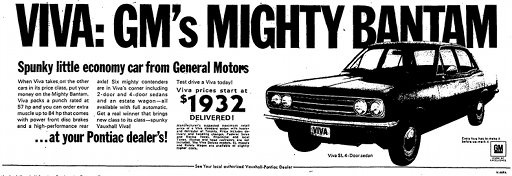
Hey VIA Rail, if you make an announcement that wireless is now free on the trains, you should really clarify that the service doesn’t actually work. So it’s not really much of a service, is it?
Author: scruss
-
no service is not free service
-
canadian compact car
This was advertised in the Globe & Mail on the day I was born:

My mum bought a second-hand Viva estate in 1975. We thought it was huge.The image is via the archive at Toronto Public Library. More cool stuff there than ever. (via)
-
XTC as The Dukes Of Stratosphear
A couple of my favourite albums are being reissued: The Dukes Of Stratosphear.
-
i can has all the animals?
Toronto Public Library has a subscription to Safari Books Online, so I no longer need to worry about the ageing O’Reilly books on my shelves. They’re all here, for free, at the latest version.
(via) -
bike, loader, snow

Someone was inexpertly practicing scales on a brass instrument nearby. The wind brought the smell of an early spring barbecue. -
a little bit on the toronto offshore wind farm and the Hélimax study
Many people (such as 1, 2, 3, 4) cite the Hélimax study Analysis of Future Offshore Wind Farm Development in Ontario [PDF] as a good reason not to even measure wind speeds off the Toronto shoreline. I would be quite surprised if most commenters had read it, as it’s not a light read, but there are three basic reasons that the report doesn’t apply:
- The report is not prescriptive; it does not outline the only viable sites in the Great Lakes. Indeed, the very last paragraph of the executive summary says “… it should be emphasized that the sites … selected do not necessarily correspond to the projects currently being developed. This report by no means seeks to disparage any sites currently under development which are not part of the 64 sites selected. There are wind power projects that can be feasibly developed beyond the sites that are identified in the present study.” A statement like that leads me to believe that the report was intended for capacity planning, and not site selection.
- The report specifically excludes Lake Ontario around the GTA on population density, even though it notes “… utilities generally prefer to have power generation close to population centres” [p.10]. Simply put, if Toronto Hydro wishes to bring wind power into Toronto, it can either have local generation where everyone sees it, or remote generation with pylons that everyone can see. Pick one.
- The mesoscale modelling that the report relies upon is unproven offshore: “… the accuracy of mean wind speeds derived from onshore mesomaps is generally assumed to be ±7%, the precision of such maps for offshore applications is not well known” [p.4]. ±7% for a mean wind speed means a lot more than seven percent in energy yield – that’s roughly good enough to tell you where you might want to start doing site selection. Indeed, the report confirms this: “… on-site meteorological measurements are required to perform a truly judicious assessment of the local wind resource and ensuing energy yields of a given site”.
So that about wraps it up for the Hélimax study pertaining to Toronto.
Others have commented that the low capacity factors of the Pickering and ExPlace turbines. Despite that fact that capacity factors for a given site are highly machine specific, there are some issues here too:
- Both sites are near large buildings which disrupt air flow. This issue goes away even a moderate distance offshore.
- Both sites are really demonstrators, and positioned for maximum public exposure rather than generation.
- The Pickering Vestas V80 was a very early model of its type, and needed a lot of TLC to get operating. I wouldn’t call it quite a prototype, but it’s not far off.
- The Pickering turbine is designed for windy (Class I) sites. It has shorter blades (80m diameter) and a bigger generator (1.8MW) than the turbines I’m most familiar with (82m diameter, 1.65MW). It will catch less wind and thus drive the generator less hard (quick, you come up with a better analogy for capacity factor … I couldn’t) than a Class II or III machine.
- The Explace turbine has smaller blades than it was supposed to – the supplier ceased trading before they were able to replace the interim 52m blade set with 58m ones. As the tower was designed for longer blades, the turbine can never be run at full speed or full generation.
- Due to the closure of Lagerwey, the ExPlace turbine has never had what I’d class as an industry-standard maintenance contract. The joint venture of TH and WindShare volunteers directs the maintenance, but there’s no permanent crew like a commercial operation would have.
So put that lidar out in the lake, and let’s see what we’ve got.
-
first groundhog of 2009
Spotted by its burrow on the embankment of the 407 at Keele St.
-
well, actually, currently none of the words
Despit the nice article in csmonitor, Wordnik isn’t yet public. Building buzz for “coming soon” websites is a bit 1999 – we want our content now, please.
-
few ties are awesome – this one just might be
 Question is, would I splash $95 on a Nicole Miller silk tie, or just soup?
Question is, would I splash $95 on a Nicole Miller silk tie, or just soup? -
WordPress 2.7.1 Upgrade Failed on 1and1.com?
bassmadrigal has the solution if WordPress automatic updates don’t work under 1and1.com hosting: WordPress 2.7.1 Upgrade Failed.
All you need to do is add the line:
AddType x-mapp-php5 .php
to your .htaccess. Joy! -
Linda Parker Hamilton — The Northern Nightingale: A Canadian Whistler
She whistles, plays autoharp, and lives locally: Linda Parker Hamilton — The Northern Nightingale.
-
the perils of tidyness
The cleaner at work threw away one of my My-Kaps, which allow you to reuse your Keurig K-Cups. This is annoying, as I’d just bought two, and only having one is a pain. They never usually tidy my desk (I think I’ve lost three “Please tidy your desk for cleaning” slips in the strata) so this is mystifying and annoying.
-
is it about a bicycle?
It’s either a great tribute to the variety of different bicycles that Batavus produces, or a boneheaded lack of standardization in their product line, but I can’t seem to get a pump from Curbside to fit my bike.
When I test-rode it, it had a Batavus-branded pump. When I got it a week later, no pump. Went back to get a pump; took it home, it was 1cm too short, and would fall out. Took that back. Got a second pump, slightly longer. Took it home; it was 1cm too long. There doesn’t seem to be any rhyme or reason to this.
It’s not as if this is a frame fit pump, where frame size matters. It’s to fit on lugs on a carrier rack. You would have thought that a sensible bicycle would have had a sensible standard …
-
sheevaplug
I ordered one of Marvell’s SheevaPlug Development Kit; wonder when it will arrive? It will make the best mini-server I could ever wish for.
-
Bob Briehl, the autoharp man in Canada
After ferrying Catherine around for another exciting adventure in LibraryQuest, we took my autoharps to Appalachian Instruments in Oakville for a repair. I have half expecting Bob to declare at least one of them a junker, but apparently they’re more than salvageable. Indeed, the older Type A is apparently a rather nice 1950s wood-bar black felt Silvertone, and the Type B, despite the warped top, is a good little player except for a couple of weak springs. Bob’s busy repairing and generally refurbing them, and we should get them back in a week or two. Should we form an autoharp folk duo?
Bob’s the local luminary of the autoharp, and has many models and spares in stock. It’s best to leave a message on the store’s phone, as he’s not always there. He also teaches, and does house calls.
Appalachian Instruments
117 Westside Drive, Oakville ON L6K 1P2
171 Solingate Drive Oakville ON L6L 3S8
(905) 845-0638Update: Bob advised of a change of address.
-
little monster

Yes, really – a Suzuki monster truck. Oh dear. -
the great thing about standards is that there are so many to choose from
I have a suspicion that, while I Want My Green Plug and their associated blog One Plug. One Planet want to replace all power adaptors with theirs, all that will really happen is that:
number_of_power_adaptor_variants = number_of_power_adaptor_variants + 1I’m not wild about their idea for DC power strips. The I2R losses would be huge.
Also, dealing with the world of input voltages and frequencies, not to mention the many plug variants, would make the thing huge, heavy and expensive.
But the fact is, there’s already a standard low voltage power adaptor: the USB mini-B.
